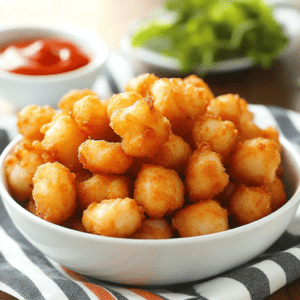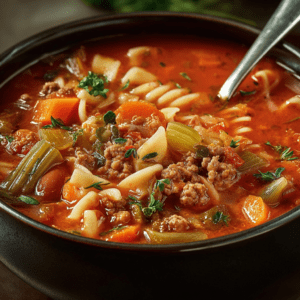If you’ve ever wondered what makes those squeaky, buttery cheese curds so irresistible, you’re in for a treat! Cheese curds are a Midwest favorite—especially in Wisconsin—but now, you can easily make them fresh right at home. Whether you love them fresh, as a crunchy fried snack, or piled atop crispy fries in classic poutine, these cheese curds deliver on flavor, texture, and fun. This recipe will quickly become a favorite in your kitchen, promising authentic, fresh curds with just a handful of simple ingredients.
What Are Cheese Curds?
Cheese curds are the fresh, soft bits of curdled milk before it becomes firm blocks of cheese. They’re moist, mildly tangy, and when truly fresh, they have that signature squeak when you bite into them—a sign of quality and freshness! You’ll find them in many delicious forms: eaten plain, breaded and fried, or as the star of Canadian poutine.
Why You’ll Love Making Cheese Curds at Home
Homemade cheese curds are surprisingly easy to make and taste so much better than store-bought versions. Plus, you control every step—from the milk you use to the seasoning and frying. You can customize your curds with spices, herbs, or coat them in crunchy breadcrumbs for a crowd-pleasing appetizer. This recipe offers a hands-on way to enjoy a true dairy delight with that fresh, squeaky texture you crave.
Ingredients

You’ll want the freshest, highest quality ingredients to get the best curds.
- 1 gallon whole milk (avoid ultra-pasteurized for better curd formation)
- ¼ teaspoon mesophilic starter culture or buttermilk (helps ferment the milk)
- ¼ teaspoon liquid rennet (diluted in ¼ cup clean, non-chlorinated water)
- ½ teaspoon calcium chloride (optional but recommended if using store-bought milk, diluted in ¼ cup water)
- 1 teaspoon cheese salt (non-iodized, to enhance flavor)
- Oil for frying (if you want to fry the curds)
- Optional for frying: seasoned flour, beaten egg wash, and breadcrumbs
Step-by-Step Instructions
1. Warm the Milk
Gently heat your whole milk in a large pot to about 90°F (32°C). Stir gently and keep a close eye on the temperature—too hot or too cold can affect the curd.
2. Add the Culture
Sprinkle in your mesophilic culture or buttermilk. Stir thoroughly to combine. Let the milk rest for about 10 minutes to allow the culture to start working, which adds flavor and helps coagulation.
3. Add Calcium Chloride (Optional)
If using, stir in the diluted calcium chloride now. This step is great for store-bought milk, improving curd texture and firmness.
4. Mix in the Rennet
Add the diluted liquid rennet and stir gently for about 30 seconds. Then let the milk sit undisturbed for 30 to 45 minutes. You’ll notice it turning into a solid mass, called the curd.
5. Cut the Curd
Once firm, cut the curd into ½-inch cubes using a long knife. This allows the whey (the liquid) to separate.
6. Slowly Heat the Curds
Gradually heat the curds to about 100-105°F (37-40°C) over 30 minutes, stirring gently to prevent the curds from clumping together.
7. Maintain the Temperature
Keep the curds at this temperature for another 30 minutes. During this time, the curds will shrink and firm up.
8. Drain the Whey
Carefully drain the liquid whey from the curds. Allow the curds to rest and mat together for about 5 minutes.
9. Cheddaring Process
Cut the matted curds into thick strips and stack them, flipping every 10-15 minutes for around 30-60 minutes. This step helps develop the classic cheese curd texture and flavor.
10. Break and Salt the Curds
Break the curds into bite-sized pieces and toss with cheese salt to taste. Fresh cheese curds are ready to enjoy!
11. Optional – Fry the Curds
For crispy fried curds, chill the curds first. Then dip them in flour, followed by egg wash, and coat with seasoned breadcrumbs. Fry in oil heated to 375°F (190°C) until golden brown and crispy—about 2-3 minutes. Drain on paper towels and serve hot.
Tips and Tricks for Perfect Cheese Curds
- Use high-quality, fresh whole milk. Avoid ultra-pasteurized milk as it won’t curdle well.
- Stir gently during heating to keep curds from matting prematurely.
- Don’t rush the cheddaring process—it develops texture and flavor.
- If frying, make sure curds are cold to prevent melting in the oil.
- Use a kitchen thermometer for precise temperature control.
- For squeaky curds, eat fresh and at room temperature—refrigeration dulls the signature squeak.
- Experiment with adding herbs or spices after salting for fun flavor twists.
Variations to Try
- Spicy Fried Curds: Mix cayenne or chili powder into your breadcrumb coating for a fiery kick.
- Garlic & Herb Curds: Add garlic powder, parsley, or Italian herbs to the flour or breadcrumbs.
- Poutine-Style: Layer fresh cheese curds on crispy fries and smother with hot gravy for a decadent Canadian classic.
- Beer-Battered Curds: Swap the breadcrumb coating for a beer batter for a pub-style twist.
- Smoked Curds: If you have a smoker or smoking gun, try adding a smoky flavor to fresh curds for a gourmet touch.
Storage and Reheating
Fresh cheese curds are best enjoyed within 1-2 days for optimal texture and flavor. Store them in an airtight container in the fridge, but take them out and let them come to room temperature before eating to revive the squeak.
If you fry your curds, keep leftovers in a paper towel-lined container in the fridge for up to 2-3 days. Reheat in an oven or air fryer at 350°F (175°C) for about 5-7 minutes to get them crispy again.
Serving Suggestions

Cheese curds are incredibly versatile:
- Serve fresh as a snack with a side of mustard or your favorite dipping sauce.
- Toss in salads for a mild cheesy boost.
- Use fried cheese curds as an appetizer or party finger food.
- Create a classic poutine by topping fries with cheese curds and hot gravy.
- Add to sandwiches or burgers for extra gooey goodness.
- Pair with cold beer or your favorite soda for the ultimate comfort food combo.
Frequently Asked Questions
Why do cheese curds squeak?
It’s all about the protein structure in fresh curds. That squeaky sound fades as the curds lose moisture over time.
Can I use store-bought milk?
Yes! Just avoid ultra-pasteurized milk, which won’t curdle properly. Whole milk works best.
Can cheese curds be frozen?
You can freeze them, but they might lose their squeak and texture. Fresh is definitely best!
Do I need special equipment?
A large pot, thermometer, a long knife for cutting curds, and cheesecloth are helpful, but nothing too fancy.
What oil is best for frying?
Use neutral oils with a high smoke point like canola, vegetable, or peanut oil.
Making cheese curds at home is a rewarding, hands-on experience that fills your kitchen with delightful aromas and results in irresistibly fresh, squeaky cheese treats. Whether you eat them straight, fry them to crispy perfection, or layer them in poutine, these homemade curds will be a star on your table. Give this recipe a try—you’ll love how easy and fun it is to bring a taste of the Midwest right to your home!

Cheese Curds
Ingredients
- 1 gallon whole milk (not ultra-pasteurized)
- 1/4 teaspoon mesophilic starter culture
- 1/4 teaspoon liquid rennet (diluted in 1/4 cup cool non-chlorinated water)
- 1/2 teaspoon calcium chloride (optional, diluted in 1/4 cup water)
- 1 teaspoon cheese salt (non-iodized)
- as needed oil for frying (optional)
- as needed flour (optional, for frying)
- as needed egg wash (optional, for frying)
- as needed breadcrumbs (optional, for frying)
Instructions
- Warm the milk to 90°F (32°C) in a large pot.
- Add the mesophilic culture and stir thoroughly. Let it sit for 2 minutes, then stir again.
- Add calcium chloride (if using) and stir. Then add the diluted rennet and stir gently for 30 seconds.
- Let the milk sit undisturbed for 45 minutes to form a curd.
- Cut the curd into 1/2-inch cubes and let it rest for 5 minutes.
- Slowly heat the curds to 105°F (40°C) over 30 minutes, stirring gently.
- Maintain the temperature and stir for another 30 minutes until curds shrink and firm up.
- Drain the whey and allow curds to mat together for 5 minutes.
- Cut the matted curds into strips and stack them, flipping every 10 minutes for 30 minutes (cheddaring).
- Break the cheddared curds into bite-sized pieces and mix in the salt.
- To fry: chill curds first. Dip in flour, then egg wash, and coat with breadcrumbs.
- Fry at 375°F (190°C) in neutral oil until golden brown, about 2-3 minutes.
- Serve fresh or fried cheese curds warm.



